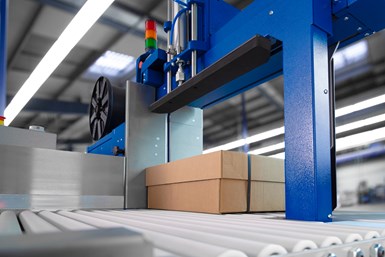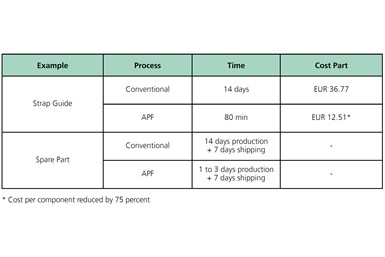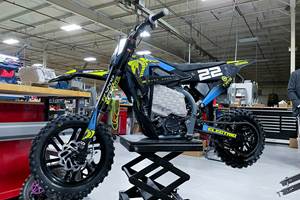Polymer AM Cuts Costs of Small-Batch Replacement Components
Producing replacement parts through polymer AM has cut Mosca’s lead times and component costs to small fractions of their original size, even when producing small batches of parts.

With over 100,000 strapping machines installed worldwide and over 2,000 components in every machine, Mosca ran into trouble developing replacement parts before it turned to additive manufacturing. Photo Credit: Arburg
Mosca, an international manufacturer of end-of-line packaging solutions, prides itself on efficiency, reliability and a customer-oriented outlook. “We have installed more than 100,000 strapping machines worldwide,” says Stefan Kessler, innovation and technology manager at Mosca’s German headquarters in Waldbrunn.
But all machines require replacements for components at some point in their lives, and with over 2,000 individual components in each Mosca machine, the manufacturer found itself hard-pressed to build an inexpensive supply of replacement parts. Reprogramming and repurposing its CNC machines to produce these parts would be inefficient for the cost and make them unavailable for their main functions. Outsourcing production through traditional methods would also prove expensive — so Kessler began to consider whether additive manufacturing could provide a viable solution for replacement parts.
Settling on Freeforming
“First, we identified over 100 different components or spare parts that were too costly to manufacture using conventional methods,” Kessler says. “Then it was a matter of finding out which 3D printer could additively manufacture these parts in a way that would meet our strength requirements.”

The PA10 (nylon 10) material the Arburg Freeformer uses meets Mosca’s strength, speed and dimensional stability requirements, maintaining the same quality as the aluminum and plastics the company had previously used. Photo Credit: Arburg
This search led Mosca to Arburg’s Freeformer system. The Arburg plastic freeforming (APF) method processes standard plastic granulates, which the company says is suitable for both prototyping and industrial additive manufacturing of functional components.
Arburg's Freeformer system met Mosca’s requirements for strength, dimensional stability and speed, and the elimination of traditional tooling made small-batch production feasible.
Reduced storage requirements and potential for unmanned production further enhanced the Freeformer’s value-add to the manufacturer. The partnership enabled Mosca to additively manufacture parts overnight and ship them to customers immediately, rather than wait through lengthy lead times.
Cost and Inventory Efficiency Through Digital Warehousing
“We print all the time,” Kessler says. “Depending on the size and geometry, the production time for a component can be less than three hours. For example, a strap guide can be additively manufactured in 80 minutes and costs, in this case, can be reduced by 75%. The ability to produce complex, lighter components significantly helps reduce our energy and transport costs.”
Programming times on CNC systems are no longer a bottleneck, and on-demand additive manufacturing has eased Mosca’s fears of over- and under-utilization of machines. The move towards digital warehousing increases efficiency and further eliminates bottlenecks for the production team.

Changing its replacement part production to additive manufacturing methods has enabled Mosca to shave weeks off delivery times while significantly reducing costs. Photo Credit: Arburg
Even with the concerns over economic utilization that typically surround AM systems, production has proved less expensive than with conventional manufacturing. Part of this is down to materials: the PA10 (nylon 10) feedstock Mosca is using has proved inexpensive compared to the aluminum or POM or PE plastics the manufacturer previously needed, even while maintaining the same quality levels.
The Future of AM at Mosca
The Freeformer has been in operation since October 2019. Mosca predominantly uses the Freeformer for production parts (around 75% of its capacity), with the rest of its use focused on prototyping, product development and innovation — enabling Kessler and the rest of the process team to explore the design freedom and diverse possibilities of the APF process. “We see great technological potential for the Freeformer when it comes to qualifying more materials and combining different materials,” he says. “We want to make two-component-parts, too.”
Related Content
Understanding HP's Metal Jet: Beyond Part Geometry, Now It's About Modularity, Automation and Scale
Since introducing its metal binder jetting platform at IMTS in 2018, HP has made significant strides to commercialize the technology as a serial production solution. We got an early preview of the just-announced Metal Jet S100.
Read MoreNew Electric Dirt Bike Is Designed for Molding, but Produced Through 3D Printing (Includes Video)
Cobra Moto’s new all-electric youth motocross bike could not wait for mold tooling. Parts have been designed so they can be molded eventually, but to get the bike to market, the production method now is additive manufacturing.
Read MoreDMG MORI: Build Plate “Pucks” Cut Postprocessing Time by 80%
For spinal implants and other small 3D printed parts made through laser powder bed fusion, separate clampable units resting within the build plate provide for easy transfer to a CNC lathe.
Read MoreAdditive Manufacturing Is Subtractive, Too: How CNC Machining Integrates With AM (Includes Video)
For Keselowski Advanced Manufacturing, succeeding with laser powder bed fusion as a production process means developing a machine shop that is responsive to, and moves at the pacing of, metal 3D printing.
Read MoreRead Next
Looking to Secure the Supply Chain for Castings? Don't Overlook 3D Printed Sand Cores and Molds
Concerns about casting lead times and costs have many OEMs looking to 3D print parts directly in metal. But don’t overlook the advantages of 3D printed sand cores and molds applied for conventional metal casting, says Humtown leader.
Read MoreVideo: Intelligent Layering Metal 3D Printing at 3DEO
Contract manufacturer 3DEO delivers metal parts using Intelligent Layering, a binder jetting-like 3D printing process the company developed and operates internally. Here’s how it works.
Read MoreTo Improve Performance of Compression Molded Composites, Add 3D Printed Preforms
9T Labs' Additive Fusion Technology enables the manufacture of composite structures with as much or as little reinforcement as is necessary, using 3D printed continuous fiber preforms to add strength just where needed.
Read More







.png;maxWidth=300;quality=90)
















